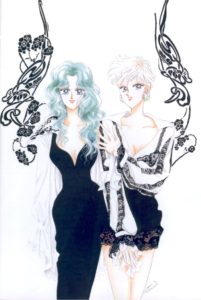 Inspired by my current reading material, Volume 5 of Sailor Moon, Eternal Edition, I have been thinking about the concept of “queerness” in Sailor Moon. This essay has no thesis – that is to say, I am not trying to prove a point, or make any conclusions, I’m simply musing on a topic that has fascinated me for many years. Our ideas of, ideals of, and language about gender and sexuality have altered tremendously in the last 25 years. I’m not the first, nor will I be the last to discuss Sailor Moon as an iconic | series for queer | fans. I encourage you all to share your thoughts and experiences in the comments. All respectful comments will be welcome – even and especially, those that disagree with any of my thoughts. As I say, I’m not making a point here, I’m merely thinking out loud in text. ^_^
Inspired by my current reading material, Volume 5 of Sailor Moon, Eternal Edition, I have been thinking about the concept of “queerness” in Sailor Moon. This essay has no thesis – that is to say, I am not trying to prove a point, or make any conclusions, I’m simply musing on a topic that has fascinated me for many years. Our ideas of, ideals of, and language about gender and sexuality have altered tremendously in the last 25 years. I’m not the first, nor will I be the last to discuss Sailor Moon as an iconic | series for queer | fans. I encourage you all to share your thoughts and experiences in the comments. All respectful comments will be welcome – even and especially, those that disagree with any of my thoughts. As I say, I’m not making a point here, I’m merely thinking out loud in text. ^_^
To begin with, I’m going to write up the list of characters in the original anime or manga (thus, Crystal) that I consider overtly queer. You may not agree, and you may also not consider this list comprehensive. This is what I consider to be a survey of the as-explicitly-as-we got queer characters. I’m leaving out common fan pairings, like Rei’s obvious feelings for Usagi (which was surfaced in her song during Sailor Moon Super Live,) Hotaru and Chibi-Usa, Ami and Makoto, because while they are all a totally valid way to interpret the characters and their dynamics, they were not created with explicit intent to be seen as what we now think of as “queer.”
Part 1: Queer Characters in Sailor Moon
Season 1: Sailor Moon / Dark Kingdom
Zoisite and Kunzite – Two of the four generals of the Dark Kingdom, serving under Queen Beryl, Zoisite and Kunzite are explicitly written as lovers in the first season of the original anime. Zoisite’s death in Kunzite’s arms is the motivation for a desperate attempt to defeat Sailor Moon which amounts to a suicide by the final general. They are portrayed very much as a Kabuki pair, with Zoisite playing the part of the onnagata, the actor who plays women’s roles.
Season 2: Sailor Moon R / Black Moon
Fiore – In the Sailor Moon R movie, Fiore’s story reads as a love story gone bitter, a kind of gender switch Kijo (which matches with Mamoru’s gender switched role as “damsel” in the series.) Fiore’s resentment of not being Mamoru’s beloved turns him into an avenging alien/demon set on the destruction of Earth and Sailor Moon.
 Season 3: Sailor Moon Super / Death Busters
Season 3: Sailor Moon Super / Death Busters
Haruka and Michiru – This perfect couple can be seen in multiple ways. Takeuchi famously declared them lesbian lovers in several interviews, and she also mentioned that Haruka was originally meant to be a Takarazuka performer. In the text of the manga, Michiru declares Haruka to be a man and a woman, which was understood by Japanese fans to refer to Ribon no Kishi‘s double-hearted lead, Sapphire. In 21st century terms, Haruka is genderfluid and can be seen wearing both women’s and men’s clothes in artbooks.
Haruka and Michiru are consistently portrayed as a couple, in all versions of the series. Never as openly as we might hope, perhaps, but the Sailor Moon musicals now have a long tradition of playing up their flirtation, their bickering and their innuendo, as well as having them launch across the stage to die in each other’s arms in seasons where that is relevant. ^_^
In Sailor Moon Super S Special and Sailor Moon Stars, their relationship is surfaced in scenes where Michiru proclaims that she has no interest in saving a world without Haruka, and the two tease each other in intimate terms. A quarter of a century after they first appeared, there’s still a lot to say about them.
Season 4: Sailor Moon SuperS / Dead Moon Circus
Fisheye – One of the Dead Moon Circus’s Amazon Trio, Fisheye is not human, but in human form, is assigned male at creation. The entirety of Fisheye’s arc is, however, testament that this is incorrect. Fisheye primarily presents as female in human guise and has a clear preference for men, making her a fairly strong transgender character. (Stronger, I would argue, than the Starlights, who were not originally intended to be men.)
Season 5: Sailor Moon Stars / Galaxia
Sailor Lead Crow and Sailor Aluminum Seiren – As Animamates, Crow and Seiren do not get a lot of screen time in the original anime, but the time they do get is memorable. When they encounter Haruka and Michiru, they are the only ones in the entire series to comment on the rose petals which accompany them. (In my head canon this is their gaydar.) They bicker often and Crow appears to have little respect for Seiren, but as their arc goes on, it becomes clear that they can be seen as a romantic couple.
Sailor Stars – In the Bishoujo Senshi Sailormoon Volume V Original Picture Collection, Takeuchi says that she was “shocked” to learn they’d be men before transformation in the anime, which indicates that the manga Starlights are all women passing as men. Nonetheless, in the original anime, the Sailor Starlights are gender variant, which opened up a whole new way for the audience to experience and identify with the characters.
Part 2: Is Queerness in Sailor Moon Progressive?
On Twitter, as I was pondering the place of Queerness in Sailor Moon, specifically, I saw a post on Twitter by E. Simins talking about anime being progressive, generally. This tweet got me thinking – in a good way. And here are some of the fruits of that thought. One of the series tweeted about was Sailor Moon because it has such positive representation of what-we-now-call-queer characters. I wanted to expand on the general idea.
In thinking about the idea that anime is “progressive” I have to say that to be progressive, I require an anime to have more than just positive representation in the narrative (or, more realistically, accidental positive representation,) I would expect to see call to action. So much of what people see as progressive thought in past anime series is either a misinterpretation (willful or misguided) about intent or origin. So if we talk about Haruka and Michiru as a “Takarazuka couple” in which Haruka is otokoyaku and Michiru is musumeyaku, we’re sort of handwaving the queerness, because Takarazuka can be interpreted as queer, but is not inherently meant to be seen that way. We’re supposed to see a man and a woman in a heterosexual partnership in a Takarazuka show. On the other hand, we know that we are supposed to see Haruka and Michiru as two women in love. Are we supposed to we think of their relationship as a positive representation of an inherent butch/femme dynamic, as genderfluid/femme couple or as a stereotype of hetero-normative male/female dynamics?
If we really want to talk about Sailor Moon being progressive in 2019, we kind of have to look at progress across time as well as geographically.
Looking at older series in which queering them makes them queer, or the queerness can be interpreted differently, is too much like saying fanon is more important than canon (which can be valid, don’t get me wrong!) It certainly was more overtly progressive than American animation in the mid-1990s. But would that make it “progressive”? Compared with something like the predatory lesbian of 1985’s Patriot Games, yes, clearly. But is that a reasonable comparison? I don’t think so. So…let’s not compare it to western media at all. Apples to apples.
So, to discuss whether anime in general or Sailor Moon in particular is progressive, let’s look at something that is not a 25-year old series. How about Asagao to Kase-san /Kase-san and Morning Glories? Both manga and anime are very positive representation of two young women falling in love. The anime was explicitly handled in a way to show “love is love.” High marks on positive representation. 10/10 for that.
 Let’s compare Kase-san to Sailor Moon. Haruka and Michiru are represented as a queer couple. They were *intended* as a positive representation of two women in love. So are Kase-san and Yamada. So, relatively equivalent. Now…here’s the major question. Is there any progress between the mid-1990’s portrayal and the late 2010’s one?
Let’s compare Kase-san to Sailor Moon. Haruka and Michiru are represented as a queer couple. They were *intended* as a positive representation of two women in love. So are Kase-san and Yamada. So, relatively equivalent. Now…here’s the major question. Is there any progress between the mid-1990’s portrayal and the late 2010’s one?
Sort of.
Kase-san and Yamada are explicitly more a “couple.” So that’s one more step for representation.
How about social or political “progress”?
Not so far.
Kase-san and Yamada have discussed living together, but there has been no discussion of real-world challenges; of talking about their relationship to family, to government, to anyone. No concerns about health or finances (okay, legitimately, they are in college, so that’s not a super important priority, but…)
What I am saying is that I see Kase-san as a positive representation – with intent – which is a form of progress, but not “progressive” in the sense of calling for social or political change. Give us Kase-san and Yamada at a Rainbow Pride parade……where an older couple of a famous race car driver and violinist come out and make rousing speeches for social progress and *then* I’ll be like, “Yes, this is progressive!” ^_^ (Which calls to mind the live action 2008 Japanese drama Last Friends, which did star a non-binary motocross rider Ruka and her beloved musician friend Michiru and it did explore issues of gender and sexuality, at least a little.)
I believe that at 16 years-old Haruka has never really thought about her gender or sexual identity, because she’s worried about the end of the world and more concerned with her identity as a Senshi. But ….after Stars, after dying twice, after building a family with Michiru, Setsuna and Hotaru…a few years later at, say 20, what is she thinking? How is she identifying herself? We can’t know with certainty, because the story will never tell us. We have the original anime, the anime adaptation of the manga, and the manga, but we don’t have the “25 years have passed and *we* understand gender and sexuality differently” version.
What happens in that version, when Hawkeye tells Fisheye, “We’re all boys here.”? What if Fisheye turns to Hawkeye and says, “No. We’re not. You two are boys. I am not.”
What happens in that version when Minako asks Haruka “are you two lovers?” or Usagi asks Haruka “are you a man or a woman?”
We can conjecture what those things might look if they were created now…but we have to accept that they might not be all that fundamentally different. It might not ever be “progressive.”
Fans of anime, despite watching media that does have positive queer representation don’t always themselves translate that into real-world progress. Although that is changing for the better in most cases, *.*gate notwithstanding. If anything, the reactive, reductive, anti-progress factions’ existence argues that progress has happened. Fans, like all humans, tend to view their entertainment through the lens of their experience. ^_^
Representation might be critical to progress, but by itself it is not “progressive.”I can acknowledge that Sailor Moon was inclusive/diverse for the time in which it was created, having been part of progress without it having been progressive . And I can accept that anime or manga I want to see pushing that needle forward might never actually go where I want it to go. ^_^
So…what is a good example of a manga that is overtly”progressive”? Shimanami Tasogare is a manga by and about sexual and gender minorities. So that stands out as a manga that is asking for genuine social change.
Whether Sailor Moon is “progressive” is open for discussion, but Shimanami Tasogare clearly asks us to move forward. And that’s progress.
![]() Nikurashii Hodo Aishiteru (憎らしいほど愛してる) subtitled in English “I love you, to hate you,” is a new adult life story about two woman who work together who are having an affair. Asano-san is the hyper-competent manager, Fujimura is a rising star in the company. The two make a formidable couple and are admired by the division in which they work.
Nikurashii Hodo Aishiteru (憎らしいほど愛してる) subtitled in English “I love you, to hate you,” is a new adult life story about two woman who work together who are having an affair. Asano-san is the hyper-competent manager, Fujimura is a rising star in the company. The two make a formidable couple and are admired by the division in which they work.

